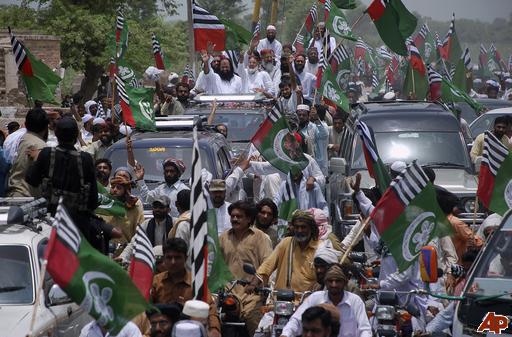 |
|
Malik Ishaq, the leader of the al Qaeda-linked Lashkar-e-Jhangvi, greets throngs of supporters after being released from custody in 2011. |
Pakistani police killed Malik Ishaq, the leader of the al Qaeda-linked Lashkar-e-Jhangvi, in a shootout in Muzaffargarh on the evening of July 28. The jihadist group’s fighters were attempting to free Ishaq and his two sons, who were in police custody. The jihadist leader had been in and out of Pakistani custody despite the fact that Lashkar-e-Jhangvi is banned in Pakistan as a terrorist organization.
Ishaq, his two sons, Usman and Haq Nawaz, and three others were arrested a week ago by the Counter-Terrorism Department (CTD), according to Dawn. CTD officers were reportedly taking Ishaq and his sons to a neighborhood in Muzaffargarh “to aid the police in recovering weapons and explosives” when they were ambush by a group of Lashkar-e-Jhangvi fighters.
The Lashkar-e-Jhangvi emir and his sons were freed and fled on motorcycles, but were subsequently intercepted by another CTD unit. Police killed Ishaq, his sons, and eight other Lashkar-e-Jhangvi fighters during a shootout. Six policemen were wounded during the firefight.
Ishaq has been in and out of Pakistani custody over the past three decades. He was detained in 1997 after admitting to murdering more than 100 Pakistanis, but was subsequently released by Pakistan’s Supreme Court in July 2011. Ishaq has dodged numerous convictions by murdering and intimidating witnesses, and even once told a judge that “dead men can’t talk.” [See Lashkar-e-Jhangvi and the “lack of evidence,” from Dawn, for more information on Pakistan’s inability to convict Ishaq and his intimidation of witnesses.]
Ishaq never hid his disdain for the political system in Pakistan, and he made it clear at the time of his release in 2011 that he intended to continue jihad.
“We are ready to lay down lives for the honor of the companions of the Holy Prophet” Ishaq said after he was released in 2011. He was met by “Kalashnikov-wielding supporters on a Land Cruiser motorcade,” Dawn reported.
Ishaq has also been accused of plotting numerous terrorist attacks while detained, including the March 3, 2009 assault on the Sri Lankan cricket team in Lahore. He would have plotted the attack and others from prison.
The Pakistani government re-arrested Ishaq in February 2013, just one month after his group had gone on a rampage in Quetta and claimed credit for a series of bombings that killed scores of Pakistanis, mostly Shiites. It is unclear exactly when he was released.
Ishaq was wanted by the US government. The US State Department added him to its list of Specially Designated Global Terrorists in February 2014.
Lashkar-e-Jhangvi’s links to al Qaeda, Taliban
The Lashkar-e-Jhangvi is an anti-Shiite terror group that has integrated with al Qaeda and the Taliban in Pakistan’s tribal areas. The jihadist group has an extensive network in Pakistan, often serves as al Qaeda’s muscle for operations, and has conducted numerous suicide and other terror attacks inside Pakistan and Afghanistan. In particular, the Lashkar-e-Jhangvi is well known for carrying out sectarian attacks against minority Shiites, Ahmadis, Sufis, and Christians in Pakistan.
The US designated the Lashkar-e-Jhangvi as a Foreign Terrorist Organization in 2003. In 2010, the US added two of the terror group’s top leaders, Amanullah Afridi and Matiur Rehman, LeJ’s operations chief, to the list of Specially Designated Global Terrorists.
The Treasury Department described Afridi as “a key figure in directing terrorist-related activities of LeJ for several years.” Afridi previously “prepared and provided suicide jackets for al Qaeda operations, trained suicide bombers and trained the assassin of Pakistani cleric Allama Hassan Turabi,” a prominent Shiite religious leader. Turabi was killed in June 2006 in Karachi by a 16-year-old Bangladeshi suicide bomber.
Rehman is a top operational leader said to manage al Qaeda’s ‘Rolodex’ of fighters who have passed through training camps and safe houses. Treasury described Rehman as Lashkar-e-Jhangvi’s “chief operational commander” and a “planning director” who has “worked on behalf of al Qaeda.”
Lashkar-e-Jhanghvi commanders have also been killed in US drone strikes in Pakistan’s tribal areas. In February 2010, the US killed Qari Mohammad Zafar, a senior Lashkar-e-Jhangvi leader as well as a leader of the al Qaeda and Taliban-linked Fedayeen-i-Islam, in a strike in North Waziristan. Zafar was behind multiple terror attacks in Pakistan and was wanted by the US for murdering a consular official in Karachi.
Pakistan added the Lashkar-e-Jhangvi to its list of terror organizations in August 2001, yet has done little to crack down on the group.








1 Comment
good riddance